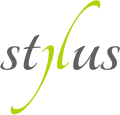This article may need to be rewritten to comply with Wikipedia's quality standards.(February 2015) |
| Stylus | |
|---|---|
 | |
| Designed by | TJ Holowaychuk |
| Developer | LearnBoost (March 29, 2011 - March 26, 2015) / Automattic (March 26, 2015 - Present) [1] |
| First appeared | 2010 |
| Stable release | 0.63.0 [2] / March 5, 2024 |
| Typing discipline | dynamic |
| OS | Cross-platform |
| License | MIT License |
| Filename extensions | .styl |
| Website | stylus-lang |
| Influenced by | |
| CSS, Sass, Less | |
Stylus is a dynamic stylesheet preprocessor language that is compiled into Cascading Style Sheets (CSS). Its design is influenced by Sass and Less. As of 2012, it was regarded as the fourth most used CSS preprocessor syntax. [3] It was created by TJ Holowaychuk, a former programmer for Node.js and the creator of the Luna language. It is written in JADE and Node.js.